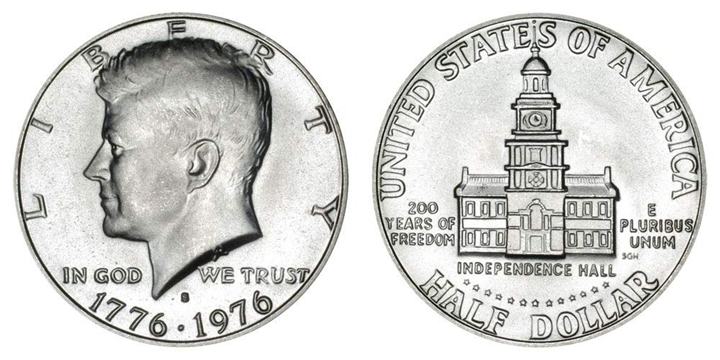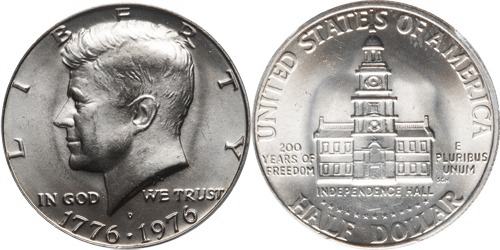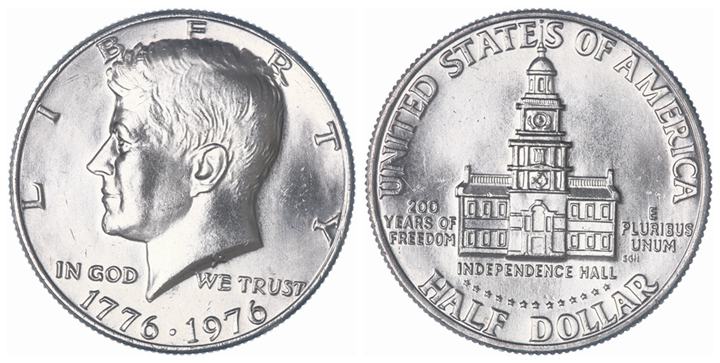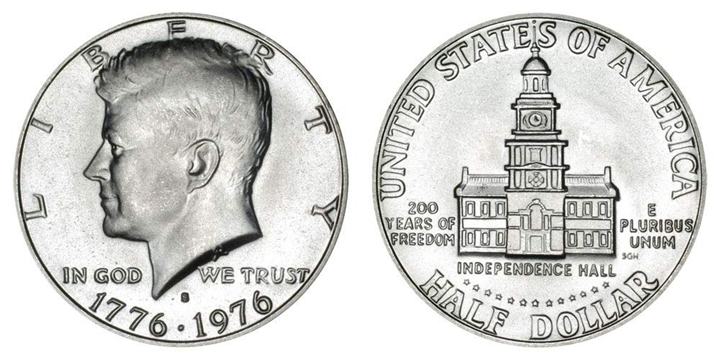When it comes to coins with unique origin stories, the 1776 – 1976 Bicentennial Half Dollar has a place in the heart of every older coin collector. The Kennedy half dollar not only marked the celebration of 200 years of freedom, but its significance also goes much further.
Even though information about this coin lies scattered on the internet, we have put together a detailed post for you. Here, we will answer the vital question: How much is a 1976 Bicentennial Half Dollar Worth.
The 1976 Bicentennial Half Dollar

Also called the 1976 Kennedy half dollar or 1776 – 1976 bicentennial half dollar, this coin was produced in two types based on composition. The first and more common type comprised copper and nickel, while the second type contained 40% silver. Collectors commonly called coins with silver components silver-clad, and those without it are simply called clad.
The silver component in the 1776 – 1976 silver half dollar almost made the already less common coin more scarce due to the Great Silver Melt. During that time, people were hoarding any coin containing any silver component and illegally melting them down for the silver. Most collectors believe that people destroyed vast amounts of silver-clad coins during the Melt.
History
The history of the 1776 – 1976 bicentennial half dollar started with the unfortunate assassination of the 35th president of the United States, the late John Fitzgerald Kennedy, on November 22, 1963. This sad event made the US Mint rush to approve a new design for the half dollar to commemorate the late president.
Production of the newly designed coins started in 1964, and everyone accepted them in a bid to honor the bereaved president. Hence, the thorough circulation of the 1976 Kennedy half dollar.
Later, to celebrate the 200 Years of the United States, three coins were approved to receive special versions. These coins were the Eisenhower Dollar, the Kennedy half dollar, and the Washington quarter. All of these special versions had new bicentennial designs on their reverse and carried the year 1776 – 1976 on their obverse.
Furthermore, the bicentennial coins were only issued from 1975 to 1976, with production ending after the celebration in 1976. However, the mintage was quite high, making the 1776 – 1976 bicentennial half dollar quite common today.
Mints
Three mints were responsible for producing the 1776 – 1976 bicentennial half dollar. They are the Denver mint, Philadelphia mint, and San Fransisco mint. Of the three, the San Fransisco mint also struck 1776 – 1976 silver-clad bicentennial and 1776 – 1976 silver-clad proof bicentennial half-dollar coins.
Statistically, the Denver and Philadelphia mints produced the most significant volume, while the San Fransisco mint struck the least amount. Nevertheless, only the San Fransisco mint produced proof, silver-clad business strikes, and silver-clad proof bicentennial half dollar coins.
| Mint | Amount |
| Denver | 287,565,248 |
| Philadelphia | 234,308,000 |
| San Fransisco (Clad Proof) | 7,059,099 |
| San Fransisco (Silver Clad Proof) | 4,000,000 |
| San Fransisco (Silver clad) | 11,000,000 |
Source: Silver Recyclers
In line with the minting location, we can divide the 1776 – 1976 Kennedy bicentennial half dollar into five series.
1776 – 1976 Kennedy Bicentennial Half Dollar Series
From the previous section, you will observe a significant difference in the amount minted from each facility. This disparity would go on to play an essential role in the value of these coins. On the other hand, the series are as follows:
- 1776 – 1976-D: This refers to the bicentennial half dollar coins struck at the Denver mint.
- 1776 – 1976: The Philadelphia mint produced these series in large amounts.
- 1776 – 1976-S Silver: Business strikes from the San Fransisco mint. These coins were silver clad.
- 1776 – 1976-S Proof: Proof coins produced from the San Fransisco mint.
- 1776 – 1976-S Silver Proof: Silver clad proof bicentennial half dollar coins struck at the San Fransisco mint.
You can easily differentiate these various series by looking for the presence of a D or S above the year on the coin’s obverse. A “D” signifies Denver mint while an “S” signifies San Fransisco mint. However, the absence of any letter indicates the Philadelphia mint.
As you might have guessed, these series have moderate to significant differences in auction prices. Especially the rarer ones.
1776 – 1976 Kennedy Bicentennial Half Dollar Features
You will find it relatively easy to recognize a bicentennial half dollar through its head/obverse and tail/reverse features.
On the coin’s head/obverse, you will find the late President John F. Kennedy’s profile at the centre. The word “LIBERTY” lie engraved along the top of the coin with Kennedy’s hair covering the bottom part of the letters “E and R.”
At the bottom of the coin, you will see the bicentennial indication “1776 * 1976” with the sentence “IN GOD WE TRUST” written above the year. However, the words are truncated by Kennedy’s neck, creating a space between “IN GOD” and “WE TRUST.”
The front view of the Independence Hall is the most prominent feature on the coin’s reverse. With the iconic Hall at the centre and its name underneath it, you will find “200 YEARS OF FREEDOM” to the left and “E PLURIBUS UNUM” to the right. At the bottom lies the denomination of the coin, which in this case, is HALF DOLLAR. Above this and below “INDEPENDENCE HALL,” you will find thirteen tiny stars.
Above all the reverse features and at the top, the “UNITED STATES OF AMERICA” lies engraved into the coin.
Note: While all Kennedy coins have the same features on the obverse, only the bicentennial half dollar has the reverse features mentioned above.
How Rare is the 1776 – 1976 Bicentennial Half Dollar?
Regarding the rarity of the 1776 – 1976 Kennedy half dollar. While this is true for those composed of nickel and copper, Kennedy coins containing silver are rarer.
There are two reasons, and the first is the overall minted amount. The San Fransisco mint, responsible for producing the silver-clad bicentennial half dollar, struck the lowest with a total amount of 22,059,099.
Of the total amount, 11,000,000 were silver business strikes, 7,059,099 were proof bicentennial half dollar coins, and 4,000,000 were silver proof bicentennial half dollar coins. Comparing these figures to the overall production of almost 600 million from the three mint locations, it is only normal that 1776 – 1976-S Kennedy half dollars are rarer.
The Great Silver Melt of the late 1970s and early ‘80s is the second reason the 1776 – 1976-S series are not as common as the others. During this time, people were either hoarding coins with silver components or illegally melting them down for the silver. As a result, many silver-clad coins in circulation were destroyed. This is the primary reason you will most likely see only coins in uncirculated conditions.
That said, 1776 – 1976-S silver-clad proof bicentennial half dollars are the rarest of the entire series.
1776 – 1976 Bicentennial Half Dollar Value
For the 1776 – 1976 half dollar series, two factors influence its value. Coin components cover the first factor and establish why the 1776 – 1976-S (proof) bicentennial half dollar fetches more prices compared to the other series.
We have covered the direct relationship between the coin’s components and its rarity in the previous section; you should check it for complete details.
Nevertheless, the rarity of this series makes it a little bit more valuable than those made of nickel and copper. The composition affects the coin’s grade somewhat.
The second factor is the grade which affects every coin out there. Coin collectors assess coins based on six attributes which are:
- Attractiveness
- Color
- Luster
- Mint
- Strike
Although these attributes form the basis for a more complex grading system, we will only cover the four basic gradings.
Good Condition
In good condition (G-4), a coin has signs of heavy wear and scratches. Its original luster and color have faded, and some of its engravings would have worn off. You can quickly identify a coin in this condition because the damage is visible to the naked eye.
Fine Condition
Also called F-12 for short, a coin in fine condition has lesser wear and scratches compared to one in good condition. In this case, Kennedy’s hair will still retain some of its details. However, the cheek should be visibly worn. Engravings and inscriptions might be faded by you can still make them out with the naked eye.
Extremely Fine Condition
Some grading systems give use PR to indicate this condition. The coin still retains its features, and Kenndy’s hair shows more intricacies because of minimal wear. It is important to note that silver-clad coins accumulate wear faster because the component is softer than nickel and copper. This inevitable wear mainly occurs in the centre of the coin, which in this case is Kenedy’s cheek.
Uncirculated Condition
For most coins in this condition, you will see the letters MS followed by two numbers.
The MS stands for mint state, and the numbers show the level of preservation. This means that an MS-60 will not be as pristine as an MS-70, for example.
However, this condition simply means the coin hasn’t undergone circulation. Therefore it retains all of its features and details from production.
An efficient way to carry out a quick grading is to examine the coin under a singular light source. This will expose most scratches, damage, and defects to the naked eye. However, it will not reveal subtler defects and for those, you need to have a professional take a look at it.
1776 – 1976-D Bicentennial Half Dollar Value

With a significant amount in circulation, the 1776 – 1976-D bicentennial half dollar doesn’t attract high prices—one such coin sold for $1.95 in fine condition. The reason for its low price is simply how easy it is to acquire one.
| Series | Price |
| 1776 – 1976-D | $1.95 |
| 1776 – 1976-D (DDR error) | $1,550. |
However, 1776 – 1976-D bicentennial half dollar coins with Double Die Reverse (DDR) mistakes can sell for much more. A Double Die Reverse error happens when two dies with different designs are used to strike the coin. In this case, a 1776 – 1976-D bicentennial half dollar with DDR sold for as much as $1,550 in good condition.
1776 – 1976 Bicentennial Half Dollar Value (No Mintmark)

The value of the 1776 – 1976 bicentennial half dollar struck at the Philadelphia Mint is not that high. In fact, it is around the same amount as those produced from the Denver mint.
An example is one that sold for $0.99 and another for as much as $1.51. Both were not in the best of conditions.
| Series | Price |
| 1776 – 1976 No Mint | $0.99 – $1.51 |
| 1776 – 1976 No Mint | $5.93 |
On the other hand, a 1776 – 1976 bicentennial half dollar in uncirculated condition sold for $5.93. However, you should expect one with an error to sell for much higher because of its rarity.
1776 – 1976-S Bicentennial Half Dollar Value

1776 – 1976-S bicentennial half dollar has a higher value than other series produced from Philadelphia and Denver. Apart from the significant difference in total struck amount, its silver component puts its price higher as the coin is said to be worth its weight in silver.
Note: It is safe to say that the value of this series can be directly linked to the current price of silver.
| Series | Price |
| 1776 – 1976-S (MS-60) | $10.50 |
| 1776 – 1976-S Proof | $12.00 |
As such, 1776 – 1976-S silver bicentennial half dollar coins have sold for as much as $10.50 with an MS-60 grade. However, a 1776 – 1976-S silver proof bicentennial half dollar was bought at $12.00. You might even get lucky enough to find one with higher silver content.
The prices will be much different for coins of these series that feature one error or the other. While some errors add more value to a coin, some reduce its value. Therefore, it is crucial to have your coin inspected and graded before listing it for sale. This will allow you to get the right amount for your coin.
Where to Sell Your 1776 – 1976 Bicentennial Half Dollar
When it comes to selling your coin, you really have two to three options. A pawn shop or local coin dealer is the first and probably most comfortable for most people. Since the coin doesn’t have that much value, some sell it quickly and easily. Hence, their preference for this method.
The second option is to list it on online platforms. While you might think it could be hard to do so, it is, in fact, easy to sell on online platforms. Also, you generally get more for what you are selling if you do it online. However, do not forget to grade your coin or have it appraised first.
Local coin dealers and pawn shops should be able to inspect and grade your coin quite easily. And this is another advantage of that option, you never know; you might have one with a highly valued error sitting in your collection.
Wrapping Up
With a unique history and purpose that celebrates freedom and the memories of a late president, the 1776 – 1976 Bicentennial half dollar should have a special place in everyone’s collection.
The good news is that it is quite easy to acquire this coin irrespective of the series. Whether you are a seasoned collector or a hobbyist, the 1776 – 1976 Bicentennial half dollar will pose little challenge for you.
Finally, the nickel and copper mixture coins will prove less difficult than silver-clad ones. Also, you will most likely come across some coated with gold and listing for higher prices. Ensure that they aren’t counterfeit before buying them.
